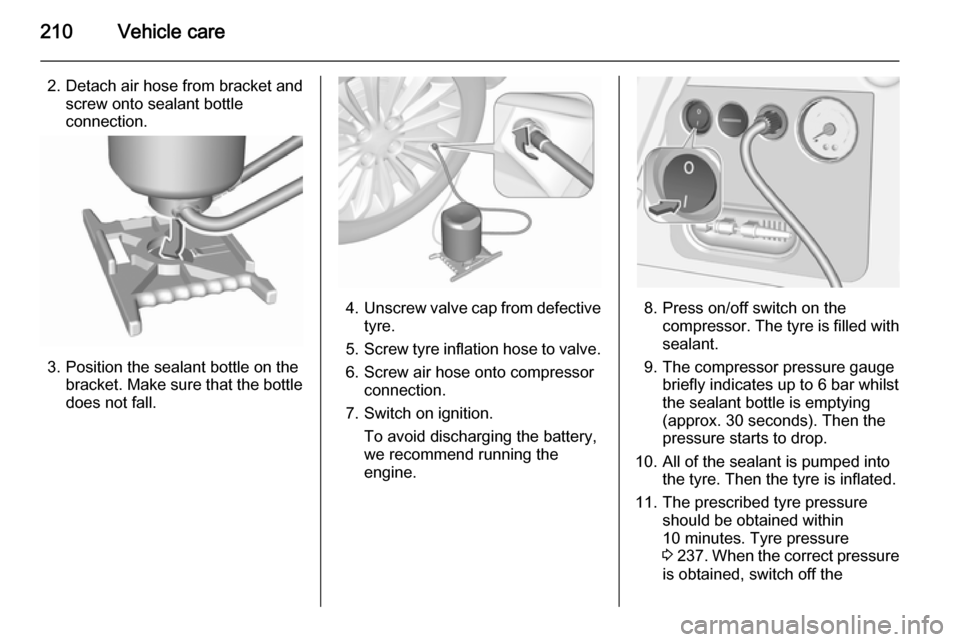ignition VAUXHALL CORSA 2015.5 Repair Manual
[x] Cancel search | Manufacturer: VAUXHALL, Model Year: 2015.5, Model line: CORSA, Model: VAUXHALL CORSA 2015.5Pages: 249, PDF Size: 7.3 MB
Page 204 of 249

202Vehicle care
If w illuminates at lower temperatures
and extinguishes after driving, this
could be an indicator for approaching
a low tyre pressure condition. Check
tyre pressure.
Vehicle messages 3 100.
If the tyre pressure must be reduced
or increased, switch off ignition.
Only mount wheels with pressure
sensors, otherwise the tyre pressure
will not be displayed and w
illuminates continuously.
A spare wheel or temporary spare
wheel is not equipped with pressure
sensors. The tyre pressure
monitoring system is not operational
for these tyres. Control indicator w
illuminates. For the further three
tyres, the system remains
operational.
The use of commercially-available
liquid tyre repair kits can impair the
function of the system. Factory-
approved repair kits can be used.
External high-power radio equipment
could disrupt the tyre pressure
monitoring system.Each time the tyres are replaced, tyre pressure monitoring system sensors
must be dismounted and serviced.
For the screwed sensor; replace
valve core and sealing ring. For the
clipped sensor; replace complete
valve stem.
Vehicle loading status Adjust tyre pressure to load condition according to the tyre information labelor tyre pressure chart 3 237, and
select the appropriate setting in the
menu Tire Load in the Driver
Information Centre (DIC), Vehicle
Menu 3 93.
Baselevel display and Midlevel
display:
Select
■ LO for comfort pressure up to
three people.
■ ECO for Eco pressure up to
three people.
■ Hi for full loading.
Uplevel display:
Page 205 of 249

Vehicle care203
Select■ Light for comfort pressure up to
three people
■ Eco for Eco pressure up to
three people
■ Max for full loading
TPMS Sensor Matching
Process
Each TPMS sensor has a unique
identification code. The identification
code must be matched to a new
wheel position after rotating the
wheels or exchanging the complete
wheel set and if one or more TPMS sensors were replaced. The TPMS
sensor matching process should also
be performed after replacing a spare
wheel with a road wheel containing
the TPMS sensor.
The malfunction light w and the
warning message or code should go
off at the next ignition cycle. The
sensors are matched to the wheel
positions, using a TPMS relearn tool,
in the following order: left side front
wheel, right side front wheel, right
side rear wheel and left side rear
wheel. The turn signal light at the
current active position is illuminated
until sensor is matched.
Consult your workshop for service or
to purchase a relearn tool. There are
2 minutes to match the first wheel
position, and 5 minutes overall to
match all four wheel positions. If it
takes longer, the matching process stops and must be restarted.
The TPMS sensor matching process
is:
1. Apply the parking brake.
2. Turn the ignition on.3. On vehicles with automatic transmission: set the selector
lever to P.
On vehicles with manual
transmission automated: Press
and hold brake pedal. Move and
hold the selector lever for
5 seconds in position N until P is
displayed in the DIC. P indicates
that the sensor matching process
of the TPMS can be started.
On vehicles with manual
transmission: select neutral.
4. Use the MENU button on the turn
signal lever to select the Vehicle
Menu in the DIC.
5. Turn the adjuster wheel to scroll to
the tyre pressure menu.
Baselevel display and Midlevel
display:
Page 206 of 249

204Vehicle care
Uplevel display:
6. Press the SET/CLR button to
begin the sensor matching
process. A message requesting
acceptance of the process should
be displayed.
7. Press the SET/CLR button again
to confirm the selection. The horn sounds twice to indicate that the
receiver is in relearn mode.
8. Start with the left side front wheel.
9. Place the relearn tool against the tyre sidewall, near the valve stem.Then press the button to activate
the TPMS sensor. A horn chirp
confirms that the sensor
identification code has been
matched to this wheel position.
10. Proceed to the right side front wheel, and repeat the procedure
in Step 9.
11. Proceed to the right side rear wheel, and repeat the procedure
in Step 9.
12. Proceed to the left side rear wheel, and repeat the procedure
in Step 9. The horn sounds twice
to indicate that the sensoridentification code has been
matched to the left side rear
wheel, and the TPMS sensor
matching process is no longer
active.
13. Turn off the ignition.
14. Set all four tyres to the recommended air pressure level
as indicated on the tyre pressure
information label.
15. Ensure the tyre loading status is set according to the selected
pressure 3 93.
Temperature dependency
Tyre pressure depends on the
temperature of the tyre. During
driving, tyre temperature and
pressure increase.
The tyre pressure value displayed in
the DIC shows the actual tyre
pressure. Therefore it is important to
check tyre pressure with cold tyres.
Tread depth
Check tread depth at regular
intervals.
Page 212 of 249

210Vehicle care
2. Detach air hose from bracket andscrew onto sealant bottle
connection.
3. Position the sealant bottle on the bracket. Make sure that the bottle
does not fall.
4. Unscrew valve cap from defective
tyre.
5. Screw tyre inflation hose to valve.
6. Screw air hose onto compressor connection.
7. Switch on ignition. To avoid discharging the battery,
we recommend running the
engine.8. Press on/off switch on the compressor. The tyre is filled withsealant.
9. The compressor pressure gauge briefly indicates up to 6 bar whilstthe sealant bottle is emptying
(approx. 30 seconds). Then the
pressure starts to drop.
10. All of the sealant is pumped into the tyre. Then the tyre is inflated.
11. The prescribed tyre pressure should be obtained within
10 minutes. Tyre pressure
3 237 . When the correct pressure
is obtained, switch off the
Page 219 of 249

Vehicle care217
2. After 5 minutes, start the otherengine. Start attempts should be
made for no longer than
15 seconds at an interval of
one minute.
3. Allow both engines to idle for approx. 3 minutes with the leads
connected.
4. Switch on electrical consumers (e.g. headlights, heated rear
window) of the vehicle receiving
the jump start.
5. Reverse above sequence exactly when removing leads.Towing
Towing the vehicle
Insert a screwdriver in the slot at the
lower part of the cap. Release the cap
by carefully moving the screwdriver
downwards.
The towing eye is stowed with the
vehicle tools 3 198.
Screw in the towing eye as far as it will
go until it stops in a horizontal
position.
Attach a tow rope – or better still a tow
rod – to the towing eye.
The towing eye must only be used for
towing and not for recovering the
vehicle.
Switch on ignition to release steering wheel lock and to permit operation of
brake lights, horn and windscreen
wiper.
Transmission in neutral.
Page 243 of 249

Customer information241Radio Frequency
Identification (RFID)
RFID technology is used in some vehicles for functions such as tyre
pressure monitoring and ignition
system security. It is also used in
connection with conveniences such
as radio remote controls for door
locking/unlocking and starting, and in- vehicle transmitters for garage dooropeners. RFID technology in
Vauxhall vehicles does not use or
record personal information or link with any other Vauxhall system
containing personal information.
Page 246 of 249

244
Headlights................................... 108Headlights when driving abroad 110
Head restraint adjustment .............8
Head restraints ............................ 34
Heated mirrors ............................. 28
Heated rear window ..................... 31
Heated steering wheel .................75
Heated windscreen .......................31
Heating ........................................ 38
Heating and ventilation system . 118
High beam ........................... 92, 109
High beam assist ..................92, 111
Hill start assist ........................... 144
Horn ....................................... 13, 75
I
Identification plate .....................226
Ignition switch positions .............129
Immobiliser ............................ 27, 92
Indicators ...................................... 82
Information displays...................... 93
Instrument cluster ........................82
Instrument panel fuse box .........196
Instrument panel illumination .....192
Instrument panel illumination control .................................... 114
Instrument panel overview ........... 10
Interior care ............................... 221
Interior lighting ............................ 114
Interior lights ...................... 114, 192Interior mirrors .............................. 29
Interruption of power supply ......138
Introduction .................................... 3
ISOFIX child restraint systems ....54
J
Jump starting ............................. 215
K Key, memorised settings ..............22
Keys ............................................. 20
Keys, locks ................................... 20
L
Lane departure warning .......90, 167
Lashing eyes ............................... 70
Light switch ................................ 108
Load compartment ................25, 67
Load compartment cover .............69
Loading information .....................72
Low fuel ....................................... 92
M Malfunction indicator light ............88
Manual anti-dazzle ......................29
Manual mode .....................137, 142
Manual transmission .................. 139
Manual transmission automated 140
Manual windows ..........................29
Memorised settings ......................22Mirror adjustment ........................... 8
Misted light covers .....................114
N
New vehicle running-in ..............129
Number plate light .....................192
O Object detection systems ...........153
Odometer ..................................... 82
Oil, engine .......................... 223, 227
Operate pedal ............................... 89
Outside temperature ....................78
Overrun cut-off ........................... 131
P Parking ................................ 18, 133
Parking assist ............................ 153
Parking brake ............................ 144
Parking lights ............................. 113
Particulate filter ........................... 134
Performance .............................. 232
Performing work ........................177
Pollen filter ................................. 127
Power outlets ............................... 81
Power steering.............................. 89
Power windows ............................ 30
Preheating ................................... 90
Puncture ..................................... 212